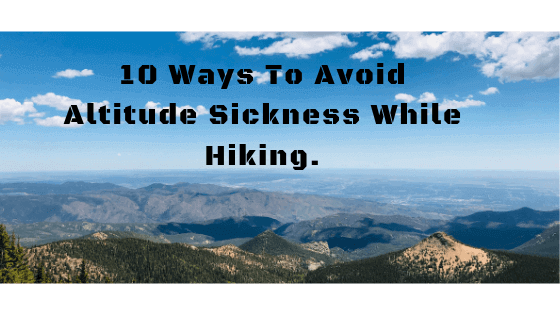
Altitude sickness is no joke!
Just ask my wife, she’ll be the first to tell you that’s it a terrible experience.
That’s why we’re sharing the 10 Ways To Avoid Altitude Sickness While Hiking.
This post may contain affiliate links meaning we make a small commission if you make a purchase through one of our links. We only promote products that we use and believe in. Click for our full Affiliate Disclosure.
We speak from first-hand experience.
On a recent hike to the Palmer Lake Reservoir in Colorado at about 8100 feet elevation my wife Julia started feeling lightheaded. We decided to stop for a few minutes and then slowly muster on. As we slowly progressed upwards on our hike she said she started feeling nauseous. That was enough for us and we decided to turn back. There’s always another day. Check out this video of our descent.
The next week we took a drive up to Pikes Peak. We fell short of making it to the peak by about 200 feet. We all felt light-headed and short of breath at this point in our trip. The view from “near” the top was breath-taking but so was the lack of oxygen.
What is altitude sickness?
Altitude sickness is caused by reduced air pressure and lower oxygen levels. Symptoms can begin to occur between 7500 and 8000 feet above sea level.
There are actually three types of altitude sickness.
Acute Mountain Sickness (AMS): This is the most common form and what we experienced on our two trips to higher elevations.
High Altitude Pulmonary Edema (HAPE): This is when fluid builds up in the lungs and can be life threatening.
High Altitude Cerebral Edema (HACE): This is the most severe form which happens when there’s fluid build up on the brain. HACE is life threatening and you should seek medical attention immediately.
What are the symptoms of altitude sickness?
- Headache.
- Dizziness or light-headed.
- Nausea or vomiting.
- Fatigue, malaise and loss of energy.
- Loss of appetite.
- Sleeping problems.
So, what can I do to avoid altitude sickness?
With the right preparation you can avoid or decrease the symptoms of altitude sickness. Here are our 10 Ways To Avoid Altitude Sickness While Hiking.
- Take it slow. Give your body time to acclimate to the increased elevation. If you start to feel any of the symptoms of altitude sickness then descend to a lower elevation immediately.
- Drink plenty of water. Dehydration can severely increase and quicken the symptoms of altitude sickness.
- Eat more carbs. This one is my favorite. Slow burning calories can be a life saver. Whole grains are the best.
- Avoid alcohol. It’s recommended to give your body up to 48 hours to acclimate to higher elevation levels prior to drinking alcohol.
- Avoid smoking. Breathing, smoking and elevation just don’t mix well.
- Take medication. See you’re doctor if you know you’re going to be hiking in higher elevations. A medication called Diamox can be prescribed which helps alleviate the symptoms of altitude sickness.
- Ginkgo Biloba. Scientific studies have shown that this natural supplement can help prevent symptoms related to altitude sickness.
- Carry bottled oxygen. There are many types of bottled oxygen for the average consumer. This can help you get some quick pure oxygen into your lungs. As always do your research. We use Boost Oxygen (affiliate link).
- Don’t overexert yourself. Altitude sickness is NOT something you can just push through. Listen to your body and…
- Rest often. Take more rest breaks. If you’re camping overnight while hiking in increased elevations make camp at about 300 – 500 feet lower than your highest hiking elevation for that day.

I think I might be experiencing altitude sickness, what do I do now?
- Descend. If you start to feel any of the symptoms of altitude sickness descend to a lower elevation immediately.
- Don’t ascend for at least 24 – 48 hours. Wait until your symptoms have subsided and then wait a day or two before attempting to ascend again.
- Take Ibuprofen. If you are experiencing a headache it’s ok to take Ibuprofen for relief.
- Drink plenty of water. Continue to hydrate. If you’re experiencing symptoms, chances are you didn’t drink enough water prior to climbing.
- Seek medical attention. If you’re symptoms continue or worsen then seek medical attention immediately.

The Earth is a beautiful place with many great places to explore but nature is not a force to be trifled with. Be prepared, be aware and most importantly, respect the awesome splendor that is nature.
Don’t be THIS guy!

Check out some of our awesome adventures at Trippin Travels.
We would love to hear your stories and share in your adventures, so please leave a comment below.
Until next time, we’ll be seeing you… ON THE TRAIL!
Congratulations! Your high-quality travel content was selected by @travelfeed curator @for91days and earned you a reward, in form of a 100% upvote and a resteem. Your work really stands out! Your article now has a chance to get featured under the appropriate daily topic on our TravelFeed blog.
Thank you for being part of the TravelFeed community!
Learn more about our travel project by clicking on the banner above and join our community on Discord
Downvoting a post can decrease pending rewards and make it less visible. Common reasons:
Submit
Hello!
This post has been manually curated, resteemed
and gifted with some virtually delicious cake
from the @helpiecake curation team!
Much love to you from all of us at @helpie!
Keep up the great work!
Manually curated by @livvu.
Downvoting a post can decrease pending rewards and make it less visible. Common reasons:
Submit
Downvoting a post can decrease pending rewards and make it less visible. Common reasons:
Submit